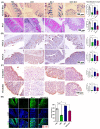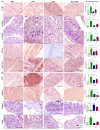Red Cabbage Juice-Mediated Gut Microbiota Modulation Improves Intestinal Epithelial Homeostasis and Ameliorates Colitis
- PMID: 38203712
- PMCID: PMC10778654
- DOI: 10.3390/ijms25010539
Red Cabbage Juice-Mediated Gut Microbiota Modulation Improves Intestinal Epithelial Homeostasis and Ameliorates Colitis
Abstract
Gut microbiota plays a crucial role in inflammatory bowel diseases (IBD) and can potentially prevent IBD through microbial-derived metabolites, making it a promising therapeutic avenue. Recent evidence suggests that despite an unclear underlying mechanism, red cabbage juice (RCJ) alleviates Dextran Sodium Sulfate (DSS)-induced colitis in mice. Thus, the study aims to unravel the molecular mechanism by which RCJ modulates the gut microbiota to alleviate DSS-induced colitis in mice. Using C57BL/6J mice, we evaluated RCJ's protective role in DSS-induced colitis through two cycles of 3% DSS. Mice were daily gavaged with PBS or RCJ until the endpoint, and gut microbiota composition was analyzed via shotgun metagenomics. RCJ treatment significantly improved body weight (p ≤ 0.001), survival in mice (p < 0.001) and reduced disease activity index (DAI) scores. Further, RCJ improved colonic barrier integrity by enhancing the expression of protective colonic mucins (p < 0.001) and tight junction proteins (p ≤ 0.01) in RCJ + DSS-treated mice compared to the DSS group. Shotgun metagenomic analysis revealed an enrichment of short-chain fatty acids (SCFAs)-producing bacteria (p < 0.05), leading to increased Peroxisome Proliferator-Activated Receptor Gamma (PPAR-γ) activation (p ≤ 0.001). This, in turn, resulted in repression of the nuclear factor κB (NFκB) signaling pathway, causing decreased production of inflammatory cytokines and chemokines. Our study demonstrates colitis remission in a DSS-induced mouse model, showcasing RCJ as a potential modulator for gut microbiota and metabolites, with promising implications for IBD prevention and treatment.
Keywords: Dextran Sodium Sulfate (DSS); colitis; gut microbiota; inflammatory bowel disease (IBD); red cabbage; short-chain fatty acids (SCFAs).
Conflict of interest statement
Christian L Lorson is the co-founder and CSO of Shift Pharmaceuticals, and Surinder Batra is one of the co-founders of Sanguine Diagnostics and Therapeutics, Inc., located in Omaha, NE, USA.
Figures








Update of
-
Red cabbage juice-mediated gut microbiota modulation improves intestinal epithelial homeostasis and ameliorates colitis.bioRxiv [Preprint]. 2023 Aug 24:2023.08.23.554560. doi: 10.1101/2023.08.23.554560. bioRxiv. 2023. Update in: Int J Mol Sci. 2023 Dec 30;25(1):539. doi: 10.3390/ijms25010539. PMID: 37662255 Free PMC article. Updated. Preprint.
References
-
- Molodecky N.A., Soon I.S., Rabi D.M., Ghali W.A., Ferris M., Chernoff G., Benchimol E.I., Panaccione R., Ghosh S., Barkema H.W., et al. Increasing incidence and prevalence of the inflammatory bowel diseases with time, based on systematic review. Gastroenterology. 2012;142:46–54.e42. doi: 10.1053/j.gastro.2011.10.001. quiz e30. - DOI - PubMed
-
- IBD Statistics 2022: Crohn’s and Ulcerative Colitis. [(accessed on 5 April 2023)]. Available online: https://ampersandhealth.co.uk/myibdcare/resources/ibd-statistics-2022-cr...
MeSH terms
Grants and funding
LinkOut - more resources
Full Text Sources

